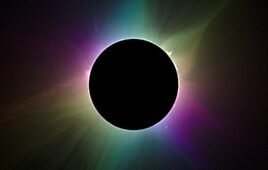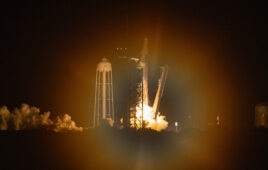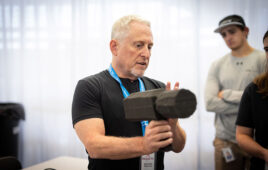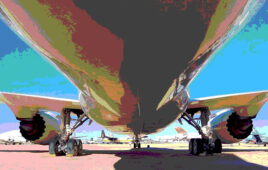The LCROSS visible camera image showing the ejecta plume at about 20 seconds after the Centaur impact. Credit: NASA |
Bring
a filter if you plan on drinking water from the moon. Water ice
recently discovered in dust at the bottom of a crater near the moon’s
south pole is accompanied by metallic elements like mercury, magnesium,
calcium, and even a bit of silver. Now you can add sodium to the mix,
according to Dr. Rosemary Killen of NASA’s Goddard Space Flight Center
in Greenbelt, Md.
Recent
discoveries of significant deposits of water on the moon were
surprising because our moon has had a tough life. Intense asteroid
bombardments in its youth, coupled with its weak gravity and the Sun’s
powerful radiation, have left the moon with almost no atmosphere. This
rendered the lunar surface barren and dry, compared to Earth.
However,
due to the moon’s orientation to the Sun, scientists theorized that
deep craters at the lunar poles would be in permanent shadow and thus
extremely cold, and able to trap volatile material like water as ice if
such material were somehow transported there, perhaps by comet impacts
or chemical reactions with hydrogen, a major component of the solar
wind.
The October 9, 2009 impact of NASA’s Lunar CRater Observation and Sensing Satellite
(LCROSS) spacecraft into the permanently shadowed region of the Cabeus
crater confirmed that a surprisingly large amount of water ice exists in
this region, along with small amounts of many other elements, including
metallic ones.
LCROSS
was launched June 18, 2009 as a companion mission to NASA’s Lunar
Reconnaissance Orbiter, or LRO, from NASA’s Kennedy Space Center in
Florida. After separating from LRO, the LCROSS spacecraft held onto the
spent Centaur upper stage rocket of the launch vehicle, executed a lunar
swingby, and entered into a series of long looping orbits around Earth.
After
traveling approximately 113 days and nearly 5.6 million miles (9
million km), the Centaur and LCROSS separated on final approach to the
moon. Moving faster than most rifle bullets, the Centaur impacted the
lunar surface with LCROSS and LRO watching using their onboard
instruments. Approximately four minutes of data were collected by LCROSS
before the spacecraft itself impacted the lunar surface.
Killen and her team observed the LCROSS impacts with the National Solar Observatory’s McMath-Pierce solar telescope
at the Kitt Peak National Observatory, Tucson, Ariz. They were the only
team able to see the results of the impacts from the ground.
The
impacts vaporized volatile material from the bottom of Cabeus crater,
including water and sodium. After the vapor plume rose about 800 meters
(around 2,600 ft)—high enough to clear the shadow from the crater
rim—sunlight stimulated the sodium atoms, causing them to emit their
signature yellow-orange glow. A high-resolution Echelle spectrometer
attached to the telescope detected this unique glow. The instrument
separates light into its component colors to identify materials by the
characteristic colors they emit when energized by radiation or other
events in space.
The
spectrometer views the sky through a narrow slit to separate the
colors, so the team had to make assumptions about the shape and
temperature of the plume to estimate the total amount of sodium
liberated by the impacts. Using a computer model of the impact and other
data on the impacts from instruments on LCROSS and LRO to guide their
assumptions, the team calculated that about one to two kilograms (about
2.2 to 4.4 pounds) of sodium were released. “This is one to two percent
of the amount of water released by the impacts,” said Killen. “Our
oceans have a comparable sodium to water ratio – about one percent.”
(The amount of sodium derived from the observations depends on the
assumed temperature of the vapor.)
A flash of infrared light from sodium vapor released at the Centaur impact site, detected with the LCROSS mid infrared camera. Credit: NASA |
This
much sodium raises the question: where did it all come from? Sodium
atoms from comet impacts could bounce across the lunar surface until
they landed in the permanently shadowed regions, where they would get
“cold trapped”— frozen in place. The solar wind carries small amounts
of sodium, which could become embedded in the lunar surface, and it
might also liberate sodium from lunar rocks, which are about 0.4%
sodium. Sodium is also liberated from lunar rocks by meteoroid impacts.
(The LCROSS impacts didn’t have enough energy to vaporize rock, so it’s
unlikely the sodium vapor plume simply came from rocks at the impact
site, according to Killen.)
“Two
percent sodium to water is consistent with the amount of sodium in
comets, so perhaps the bulk of the sodium and water came from comet
impacts,” said Killen. She makes it clear that this is just speculation
at this point, and that it’s possible they came from a different source
or even a variety of sources, including cold-trapped lunar volatiles and
solar-wind-induced chemistry. Better evidence for a cometary origin
would come from an analysis of the hydrogen isotopes in lunar water,
according to Killen.
Isotopes
are versions of an element with different weights, or masses. For
example, a deuterium atom is a heavier version of a common hydrogen atom
because it has an extra particle – a neutron – in its nucleus at the
center. Deuterium can be substituted for the regular form of hydrogen in
a water molecule, but it is much less common than hydrogen, and its
concentration varies in objects across the solar system. If the
deuterium to hydrogen ratio in lunar water is similar to the ratio in
comets, it would suggest the water came from comet impacts. Since comets
as “dirty snowballs” carry many other materials, it would imply that
much of the sodium and other volatiles came from comets as well.
The
team plans to shed light on the origin of lunar water and other
volatiles using data from the upcoming Lunar Atmosphere and Dust
Environment Explorer (LADEE) mission, scheduled to be launched in May,
2013. The mission will orbit the moon and observe its tenuous atmosphere
(technically called an exosphere, because it is so thin, atoms rarely
collide with each other above the surface).
The research was funded by NASA’s Dynamic Response of the Environment At the Moon
(DREAM) project. “This discovery highlights a particular value of the
DREAM program – we can rapidly support missions like the LCROSS impact
with additional observations and analysis,” said Dr. William Farrell of
NASA Goddard, lead of the DREAM institute.
The
McMath-Pierce telescope is operated by the National Solar Observatory,
which is funded by the National Science Foundation and managed by the
Association of Universities for Research in Astronomy. Killen’s paper on
this research was published in Geophysical Research Letters in December
2010.






